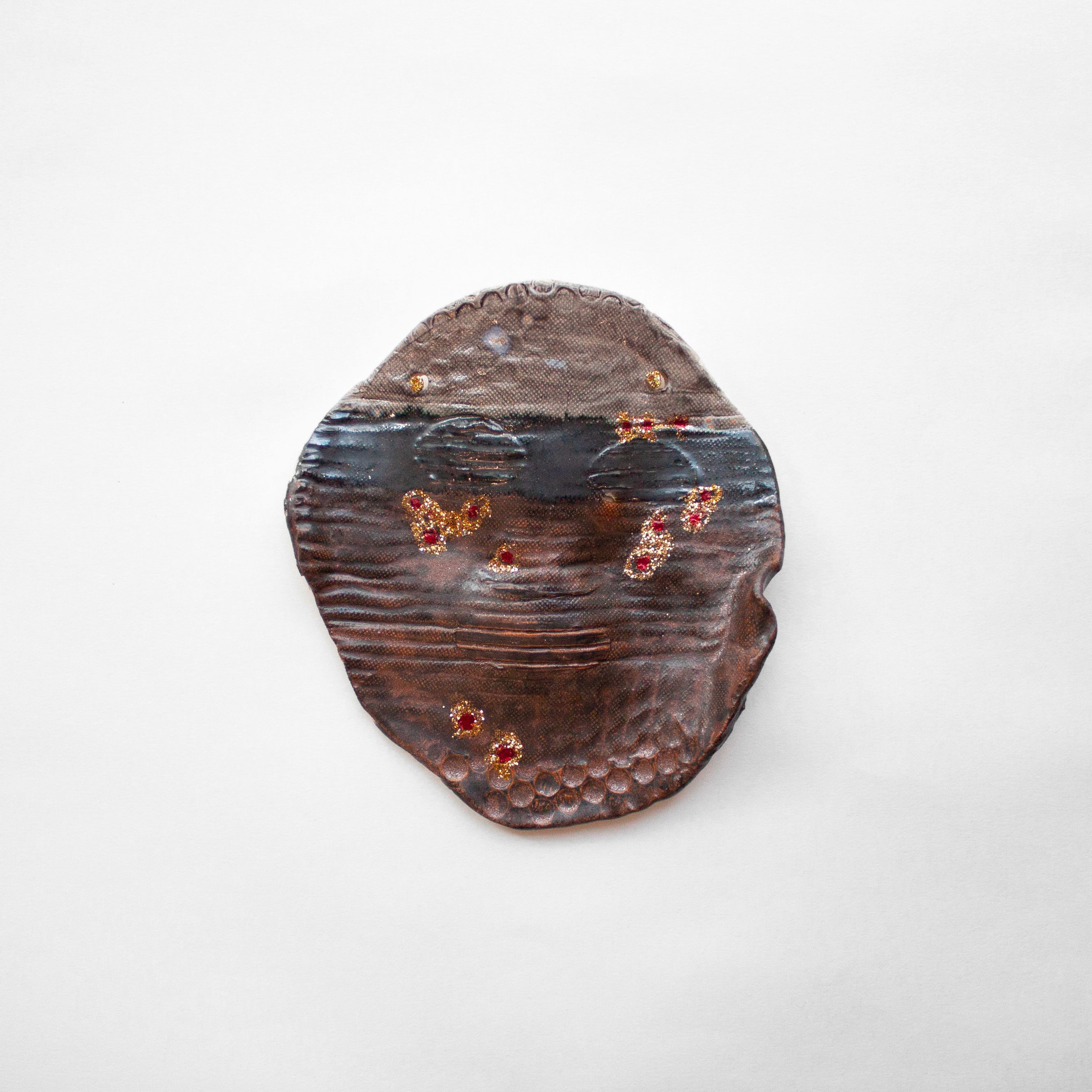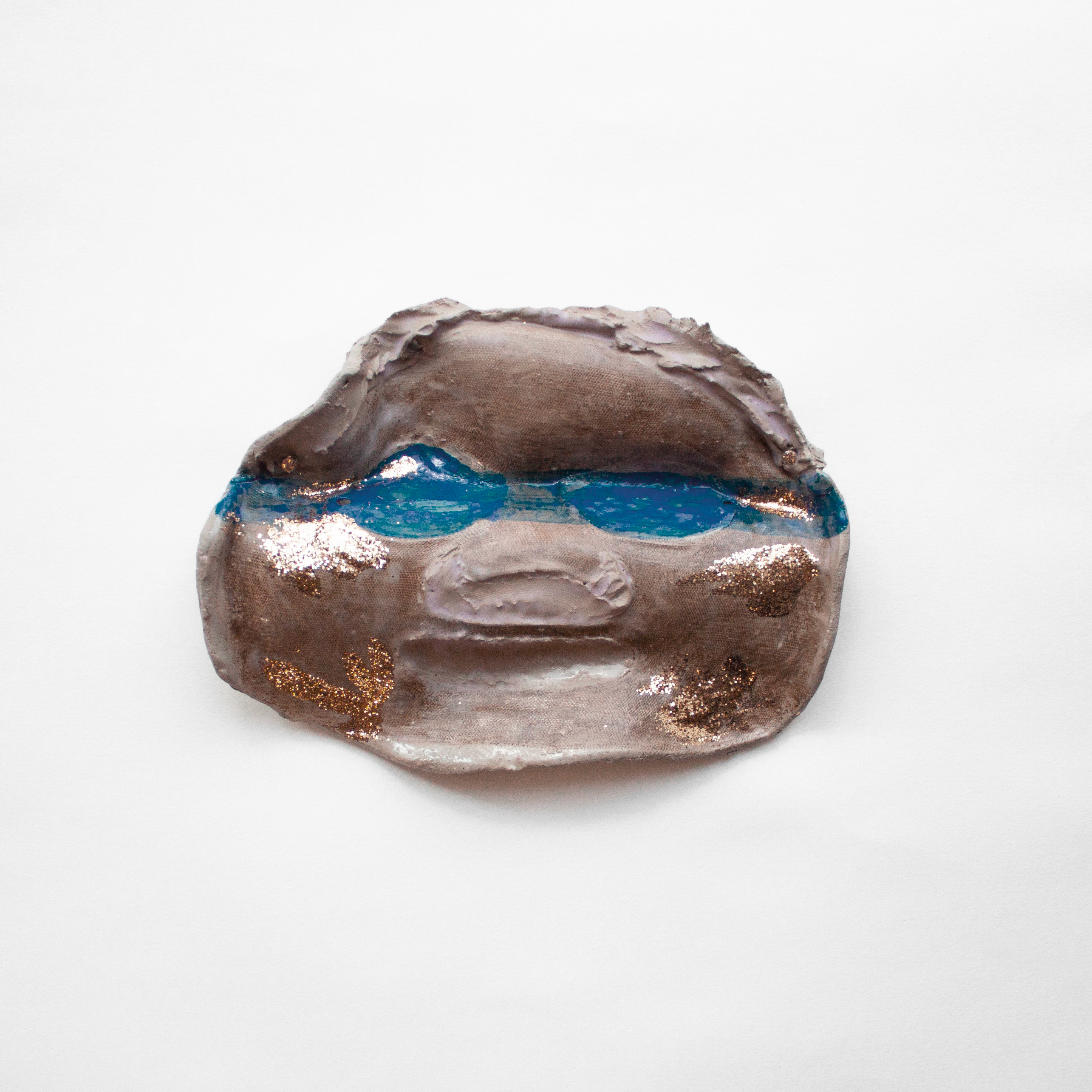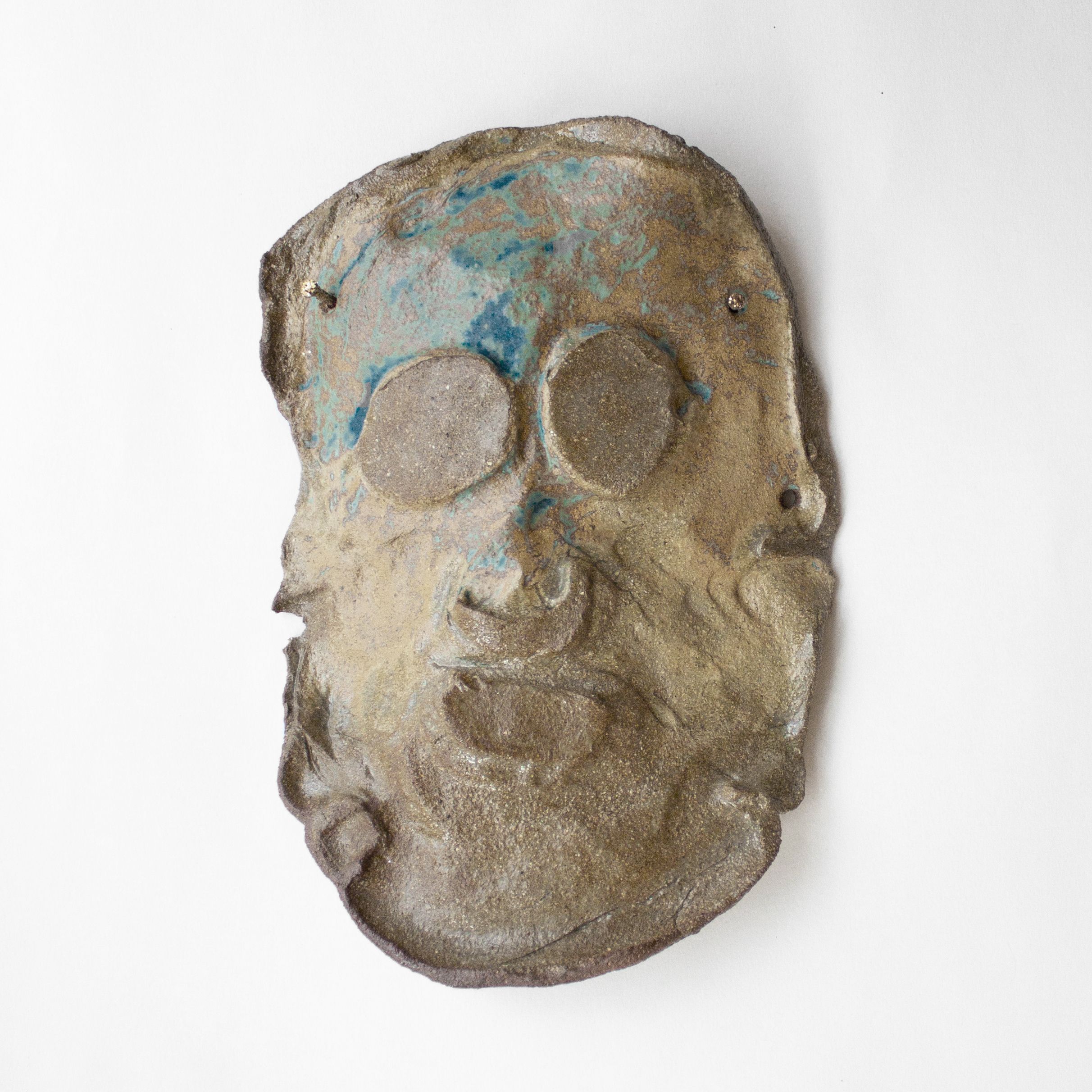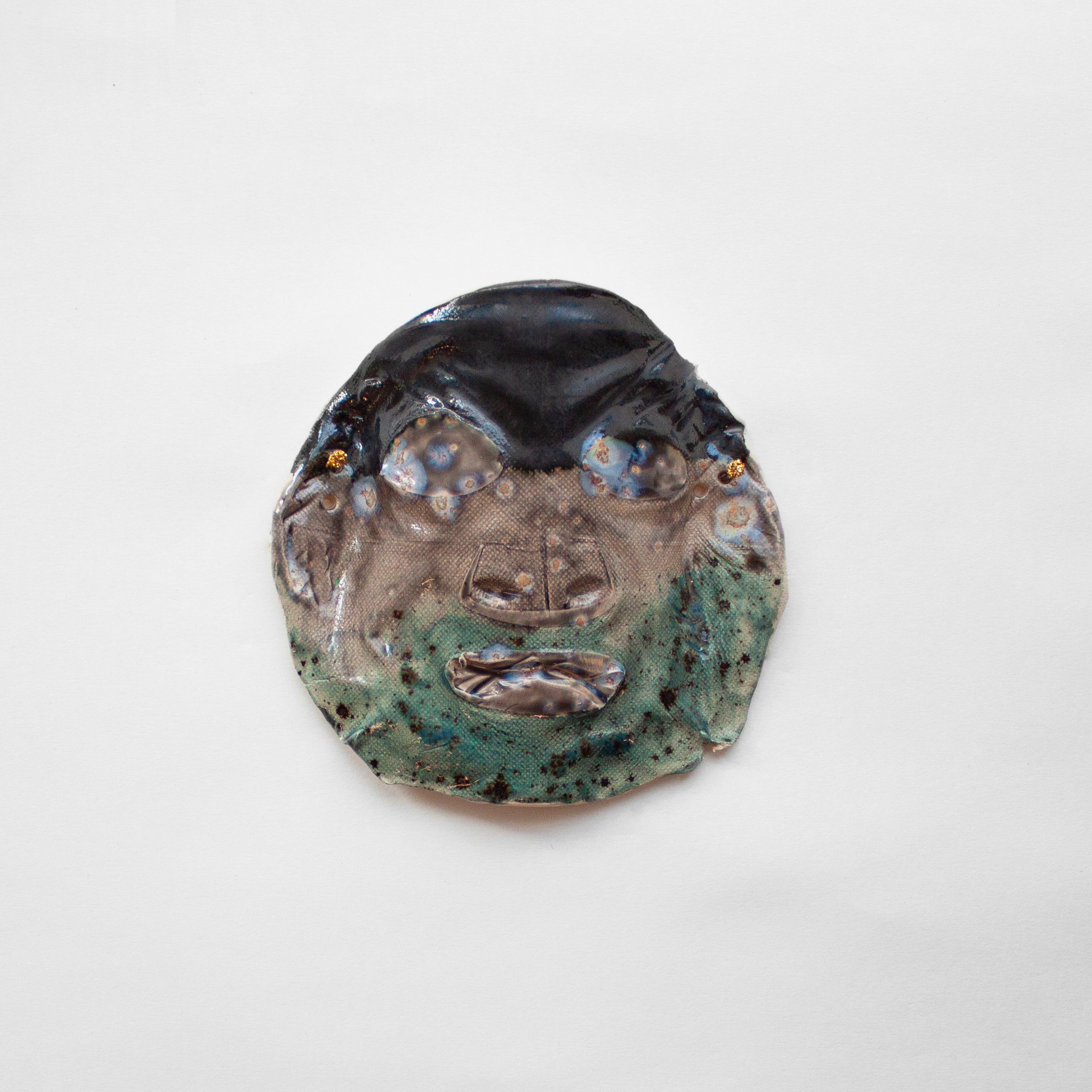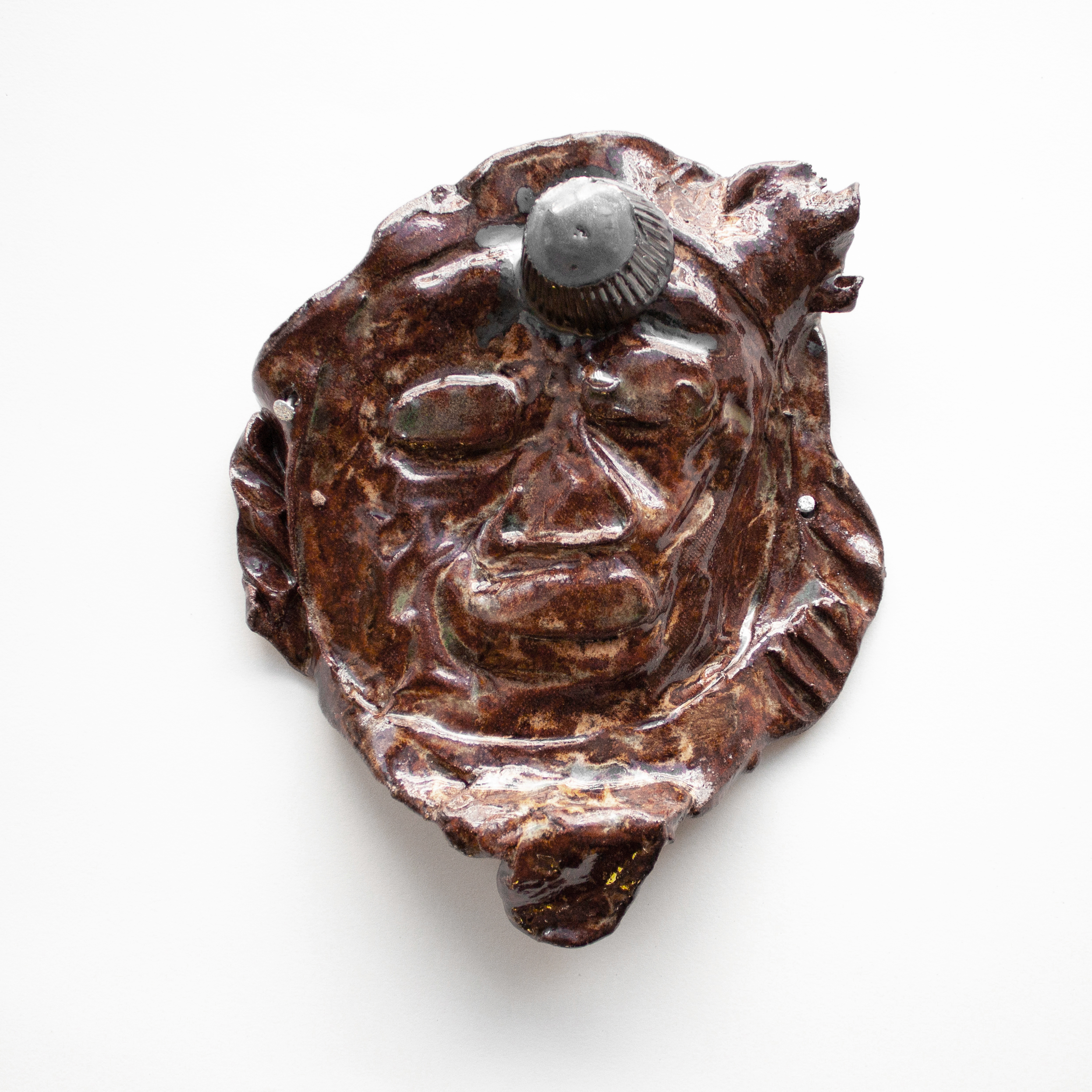Press release
Complete list of "Beauty Mask" artworks
English version
Le masque est un anti-objet par excellence. Les sémiologues parleraient d’un déictique, ce geste d’un doigt pointé là-bas, ailleurs. Qu’il appartienne à un·e acteur·ice de tragédie grecque, à un·e Anonymous, à un·e citoyen·ne immunodéprimé·e ou à un·e Snapchatteur·euse, le masque désigne autre chose que lui-même, et ce faisant, il sépare aussi les iconodules des iconoclastes. Alors, voici deux options : allez-vous croire ce qui est représenté sur la surface illusionniste ou tenterez-vous plutôt d’apercevoir l’envers du décor, au risque de sombrer dans la paranoïa ? Pile ou face, image ou objet : l’impasse provient peut-être d’avoir trop voulu s’attacher à l’origine perdue, à la déploration d’un quelconque visage nu.
Il se trouve qu’Ingrid Luche fait des masques et que ses masques en céramique portent leur objectité en étendard. La galerie Air de Paris en présente une quarantaine, accrochés au mur ou posés sur des barres. On les regarde enfin pour eux-mêmes, plus personne ne songeant à y voir de simples signes. Les œuvres, issues de la série des « Beauty masks » (2023-2024), ont été réalisées à partir de masques de beauté jetables pressés sur des pâtes de terre. À la surface de ces faciès ductiles, l’empreinte du textile synthétique demeure, déclinée au fil des variations de couleurs, d’émaux et d’accidents. Chacun d’entre eux possède des caractéristiques particulières, aussi subjectives que les mille déclinaisons individuelles d’un visage. Il faut bien se rendre à l’évidence : nos caches et nos filtres se sont autonomisés. Dès lors, nous avons beau répéter « I’m not a cat » (1) : la protestation se perd en ricochant contre une surface de grès chamarrée (2) .
« À présent, toutes nos choses (…) sont susceptibles de devenir de méchantes poupées capables de mordre avec leurs dents pointues » (3), écrivait déjà Fredric Jameson. Nous y voilà : chez Ingrid Luche, les choses mordent et les objets font leur vie. Sa sixième exposition personnelle à la galerie présente, outre les masques, de nouvelles pièces issues de séries évolutives : les « Bighands » (2022)*, les « Moonstep » (2023) et de ses « Portes » (depuis 2012). Le titre de l’exposition provient de la première de celles-ci, La Porte (Dévoré) : une porte qui n’ouvre sur rien mais qui encadre une bouche dentue. Il ne s’agit plus seulement du fameux « hangar décoré » (4) des architectes Robert Venturi, Denise Scott Brown mais bel et bien une « méchante poupée » en polystyrène, bois et aluminium. Le support se confond avec la représentation, les dualismes fusionnent en s’entre-dévorant.
La nouvelle porte (Austur-Indíafjelagið, 2024) que présente Ingrid Luche à Air de Paris est empreinte de la matérialité paradoxale de l’ensemble de sa production. La porte, en l’occurrence, est un sommier en bois aggloméré, qui accueille la reproduction peinte d’une photographie prise à Reykjavik. Il s’agit plus précisément de l’entrée d’un restaurant indien, l’artiste soulignant que « les premières formes mondialisées sont celles de la culture culinaire » (5). La porte accueille une image touristique qui, à nouveau, court-circuite l’usage ordinaire de l’image-signe. Une image qui fonctionne devrait inciter à pousser la porte pour consommer la cuisine faussement locale d’un restaurant. Or ici, il n’y a rien d’autre que cela : la customisation artisanale des scories jetables du discount planétaire, au sein d’une série que l’artiste nomme les « Chinoiseries ».
Ingrid Luche est née un an après la publication du Système des objets de Jean Baudrillard. De fait, la dénonciation cinglante de celui-ci est déjà légèrement anachronique au moment où elle réalise ses premières œuvres au début des années 1990. Là où le théoricien déplorait la « quiétude scellée par la distance au monde » induite par une consommation désinvestie (6), l’artiste produit par et pour une société qui a cessé de regretter l’original. Les œuvres-objet et les signes-sculptures d’Ingrid Luche ont beau exhiber leur matérialité bricolée et leur facture artisanale, ils appartiennent pleinement à notre système de pensée actuel : celui des objets connectés tout sauf inertes (7), en voie d’autonomisation, communicant entre eux sans l’aide des humain·es, voraces de données personnelles. On les porte souvent tout contre la peau — au risque de s’en laisser dévorer.
Ingrid Luquet-Gad
(1) Zoom Cat Lawyer ou I’m Not a Cat (soit « L’avocat chat sur Zoom » ou « Je ne suis pas un chat ») fait référence à un mème internet. Le 9 février 2021, un avocat se connecte au tribunal d’instance du Texas en oubliant de désactiver le filtre chat de son application Zoom. Se rendant compte de son erreur, il se défend en signifiant « ne pas être un chat ».
(2) En 2016, l’artiste avait déjà réalisé une série comparable de masques en céramique, les Masques arsoniens.
(3) Fredric Jameson, La totalité comme complot. Conspiration et paranoïa dans l’imaginaire contemporain, Paris, Les Prairies Ordinaires, 2007, p. 33.
(4) Voir : Robert Venturi, Denise Scott Brown et Steven Izenour, L’enseignement de Las Vegas, Bruxelles, Mardaga, 2008.
(5) Entretien avec l’artiste, le 1er juillet 2024.
(6) Jean Baudrillard, La société de consommation, ses mythes et ses structures, Paris, Denoël, 1970, p. 32.
(7) Par rapport à leur fabrication de la vie quotidienne, voir notamment : Adam Greenfield, Radical Technologies : The Design of Everyday Life, Londres, Verso Books, 2017.
* Ce projet a été sélectionné par la commission mécénat de la Fondation des Artistes qui lui a apporté son soutien.
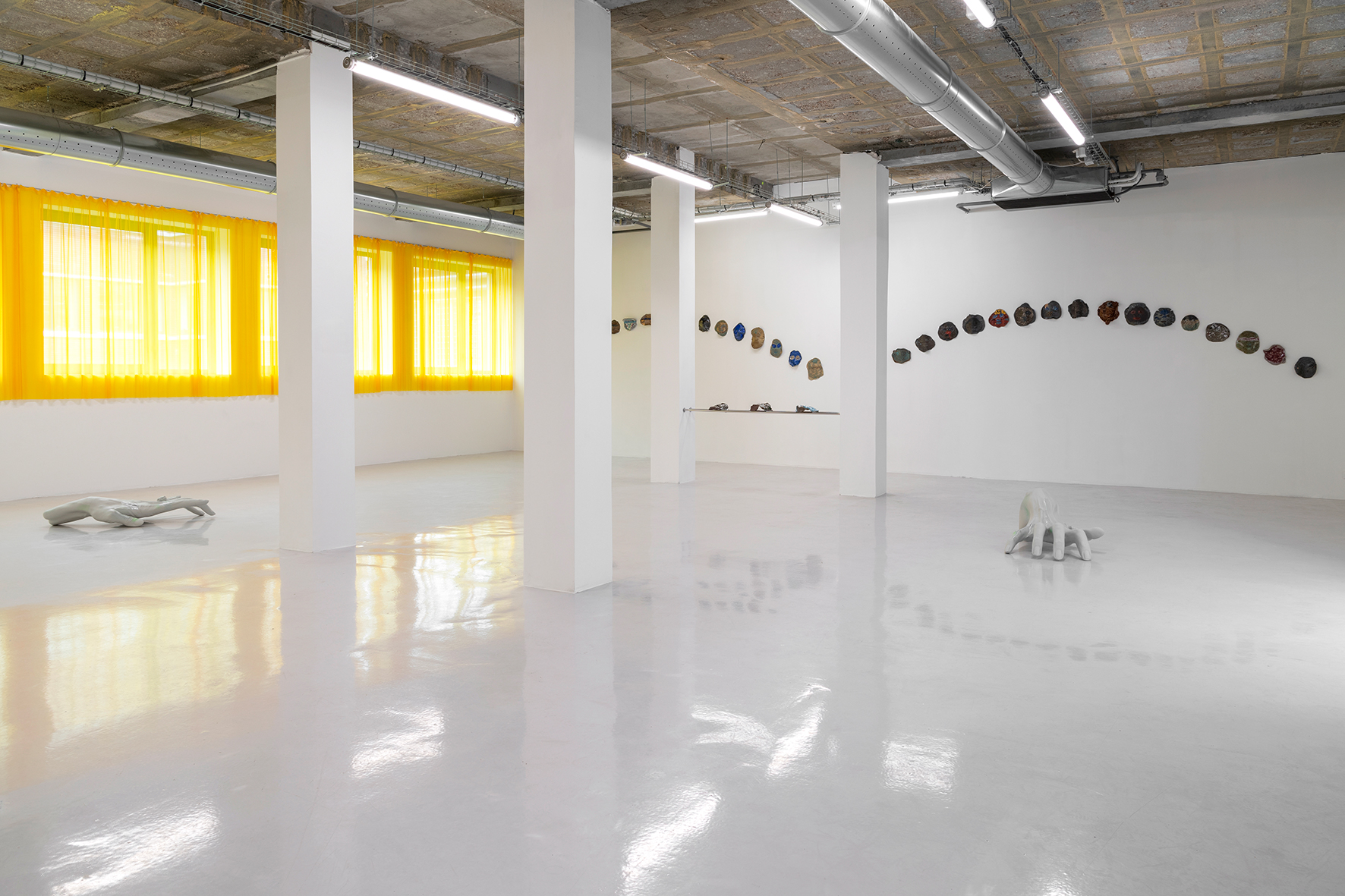
© Photo Marc Domage

© Photo Marc Domage
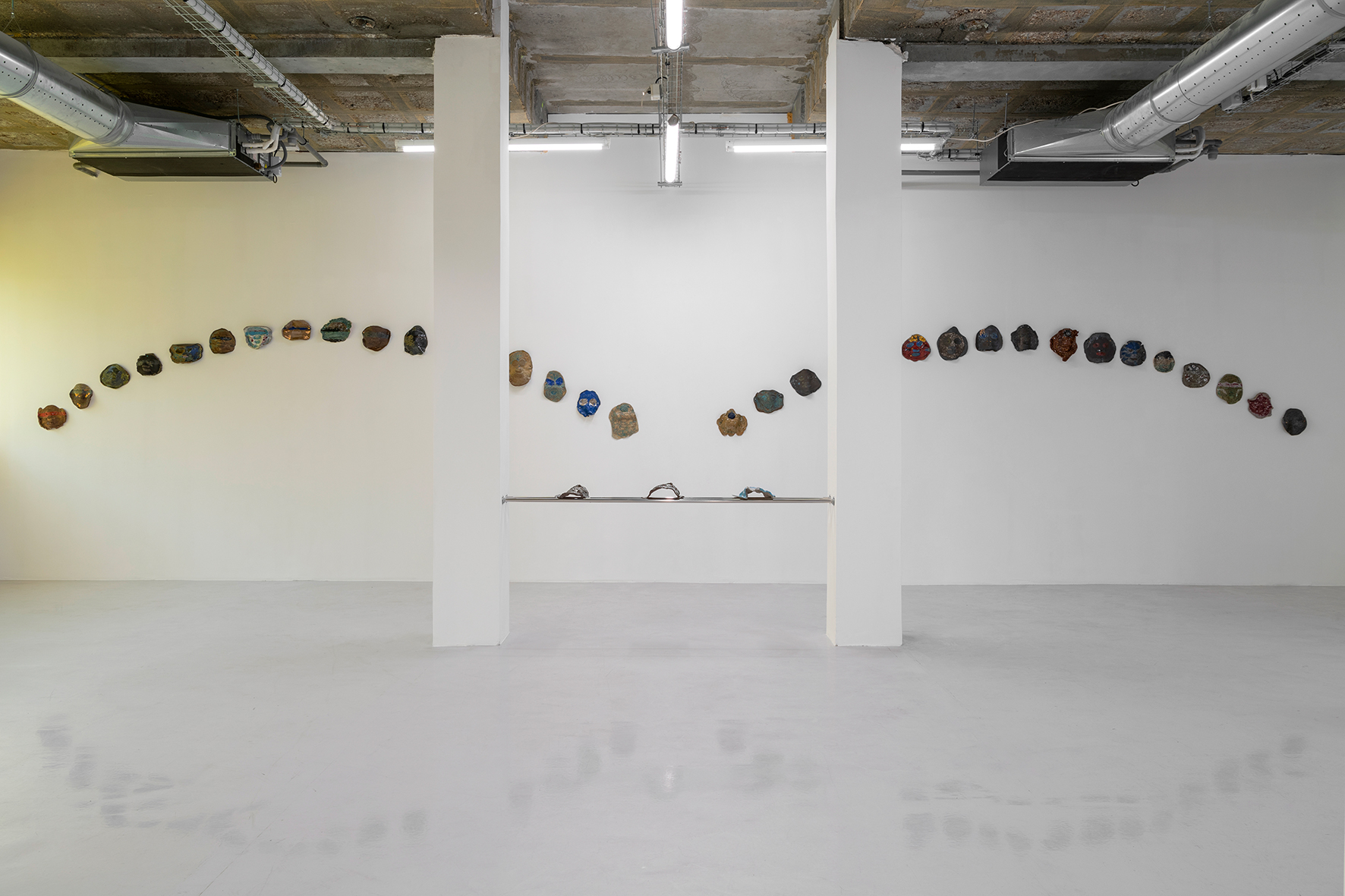
© Photo Marc Domage
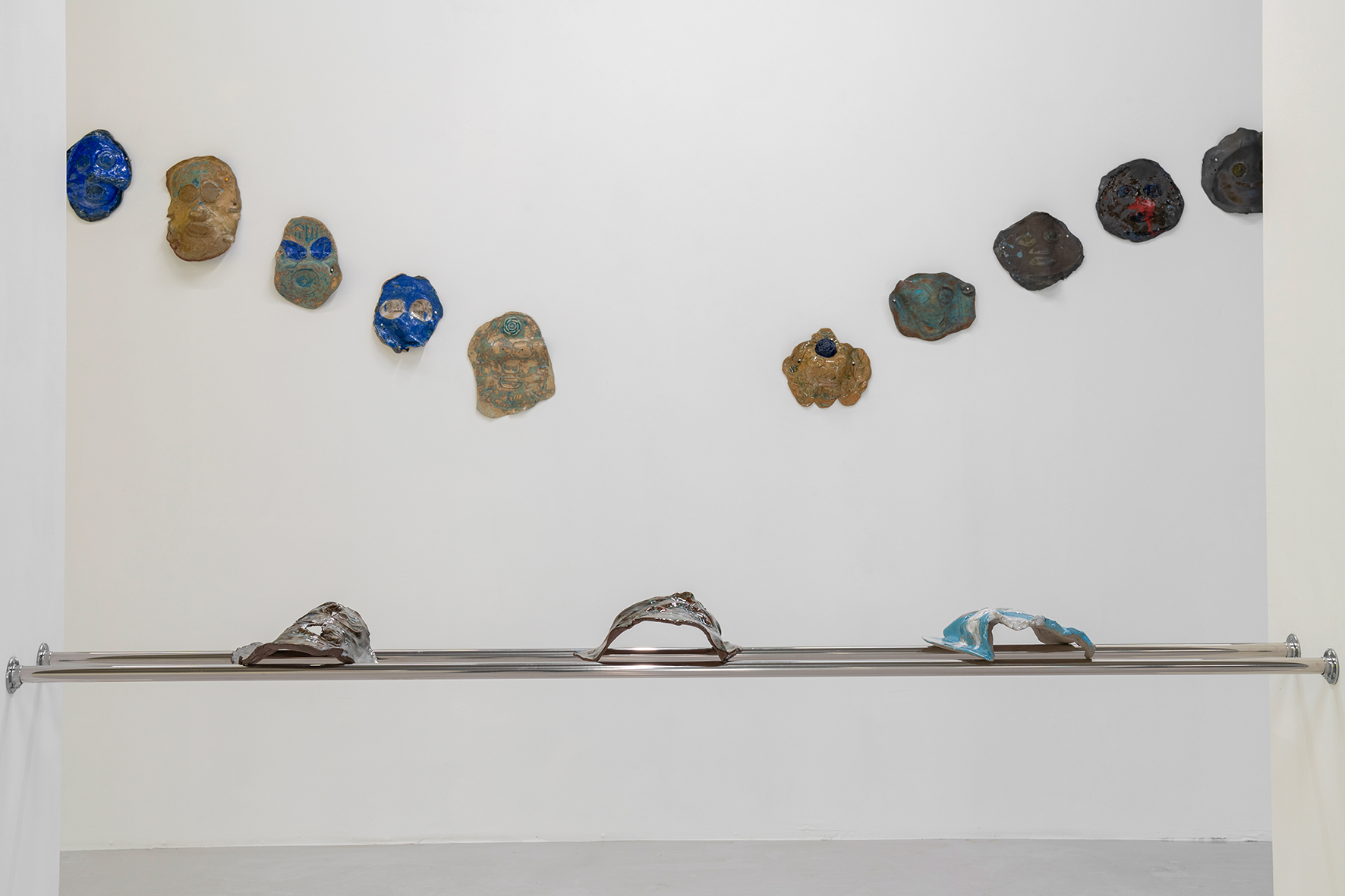
© Photo Marc Domage

© Photo Marc Domage

© Photo Marc Domage
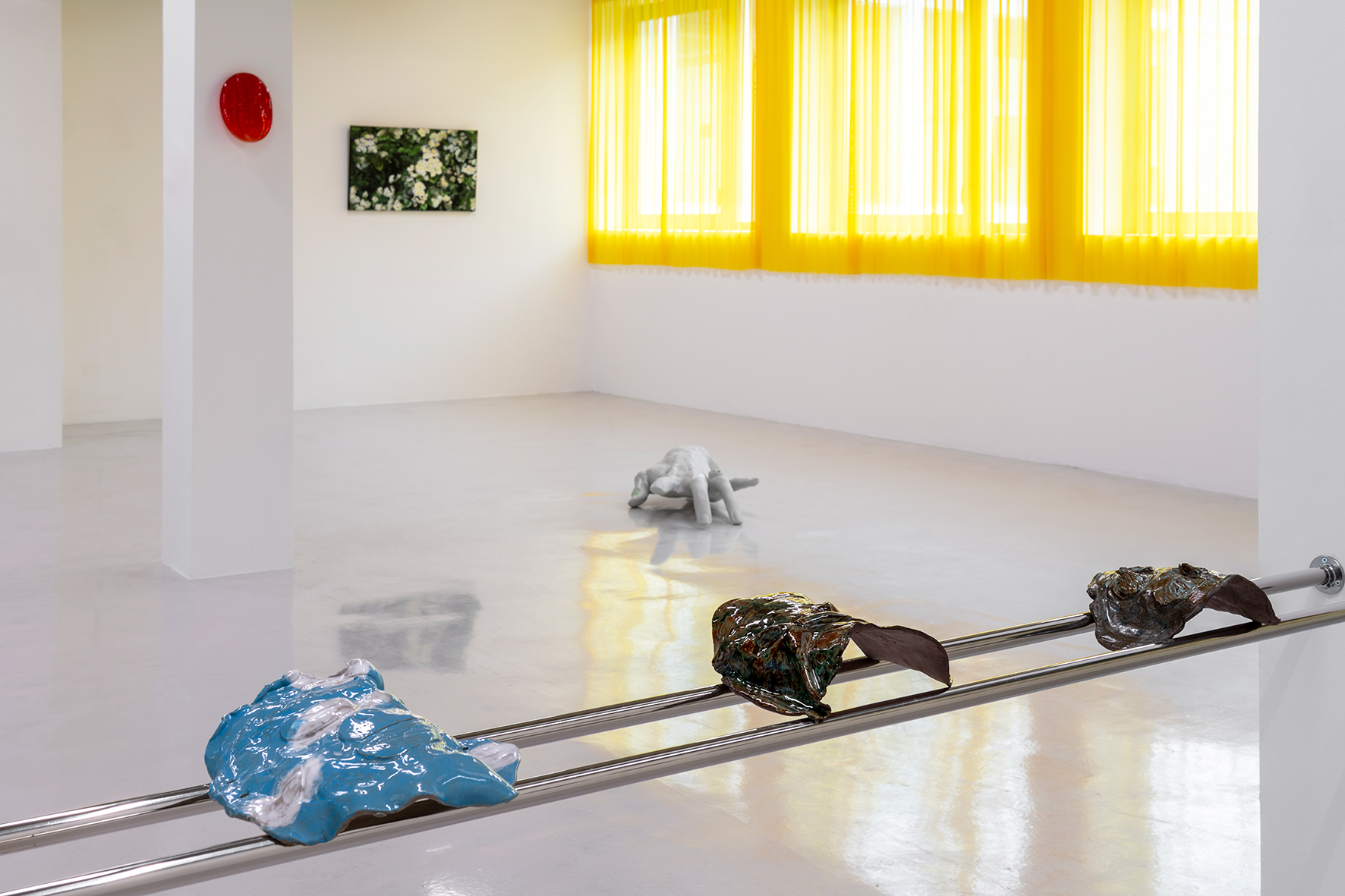
© Photo Marc Domage
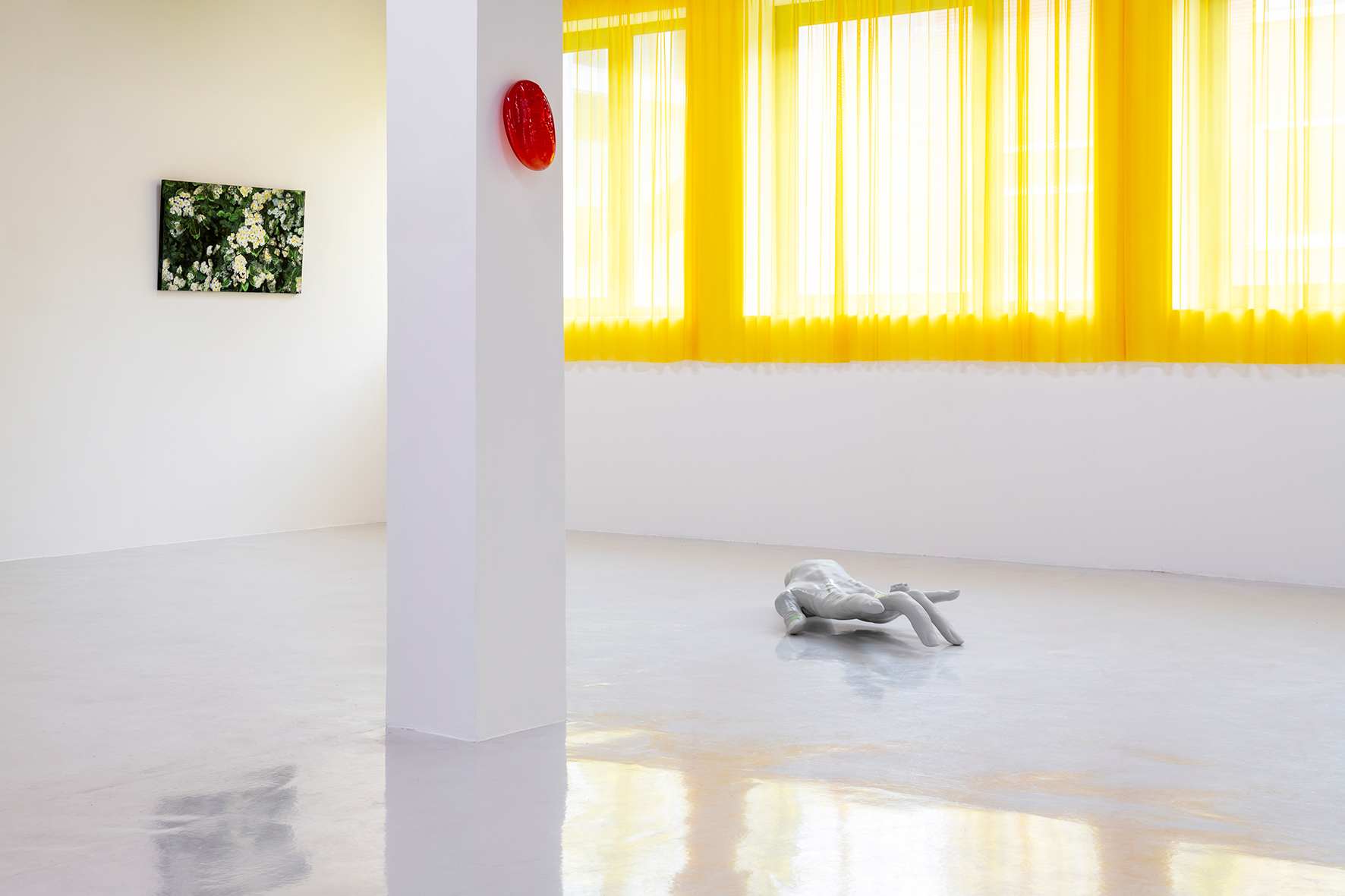
© Photo Marc Domage
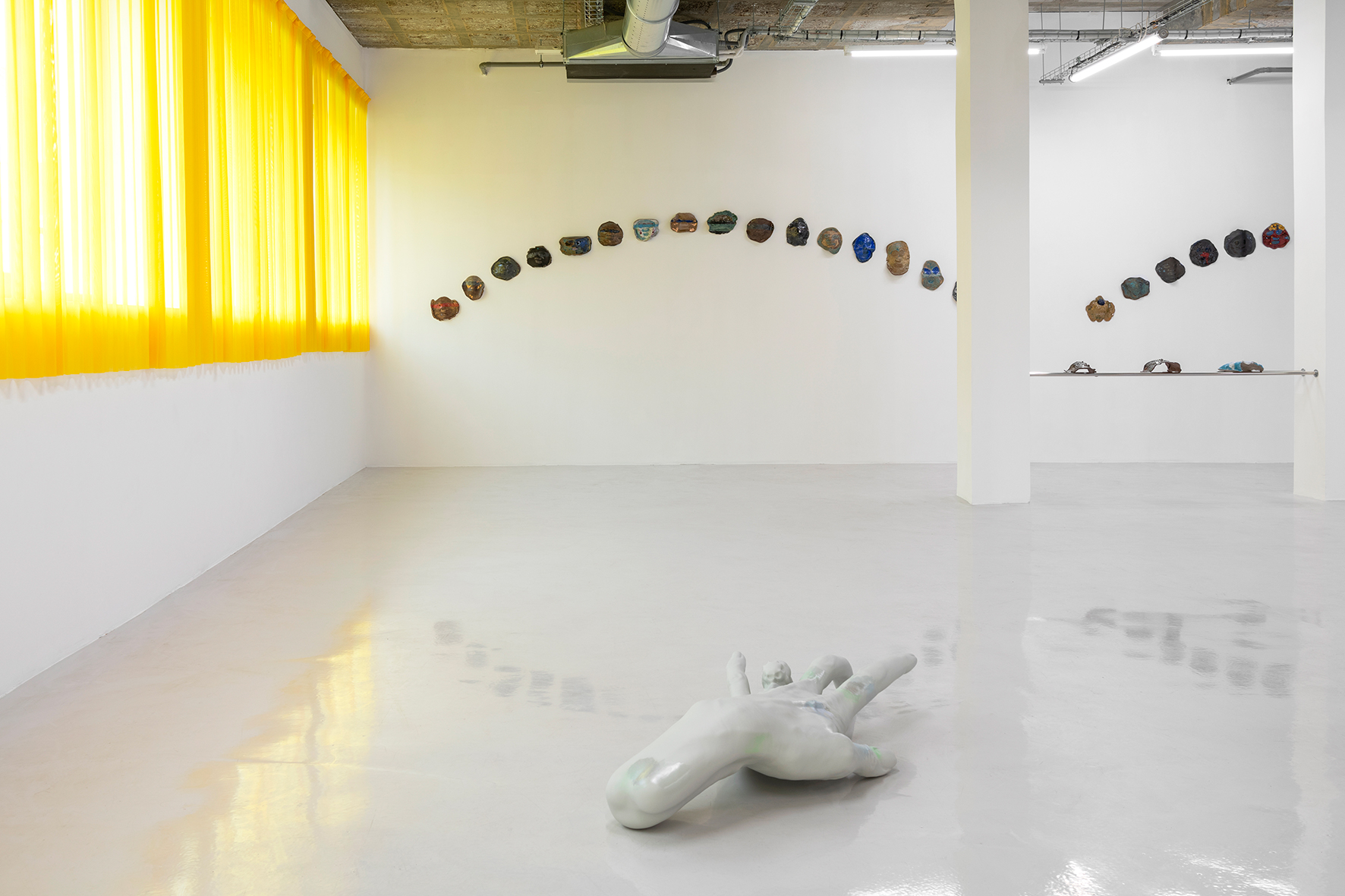
© Photo Marc Domage
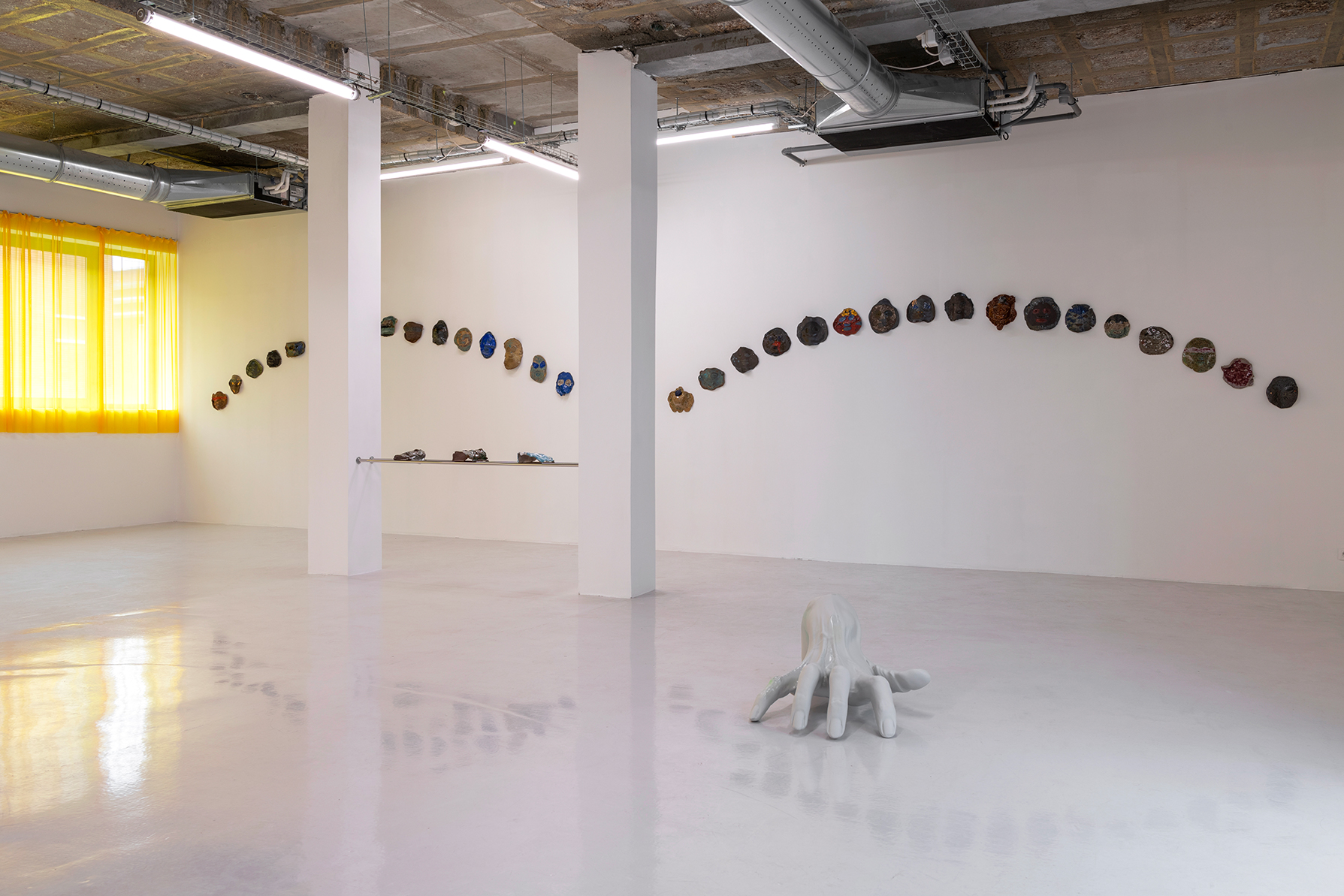
© Photo Marc Domage
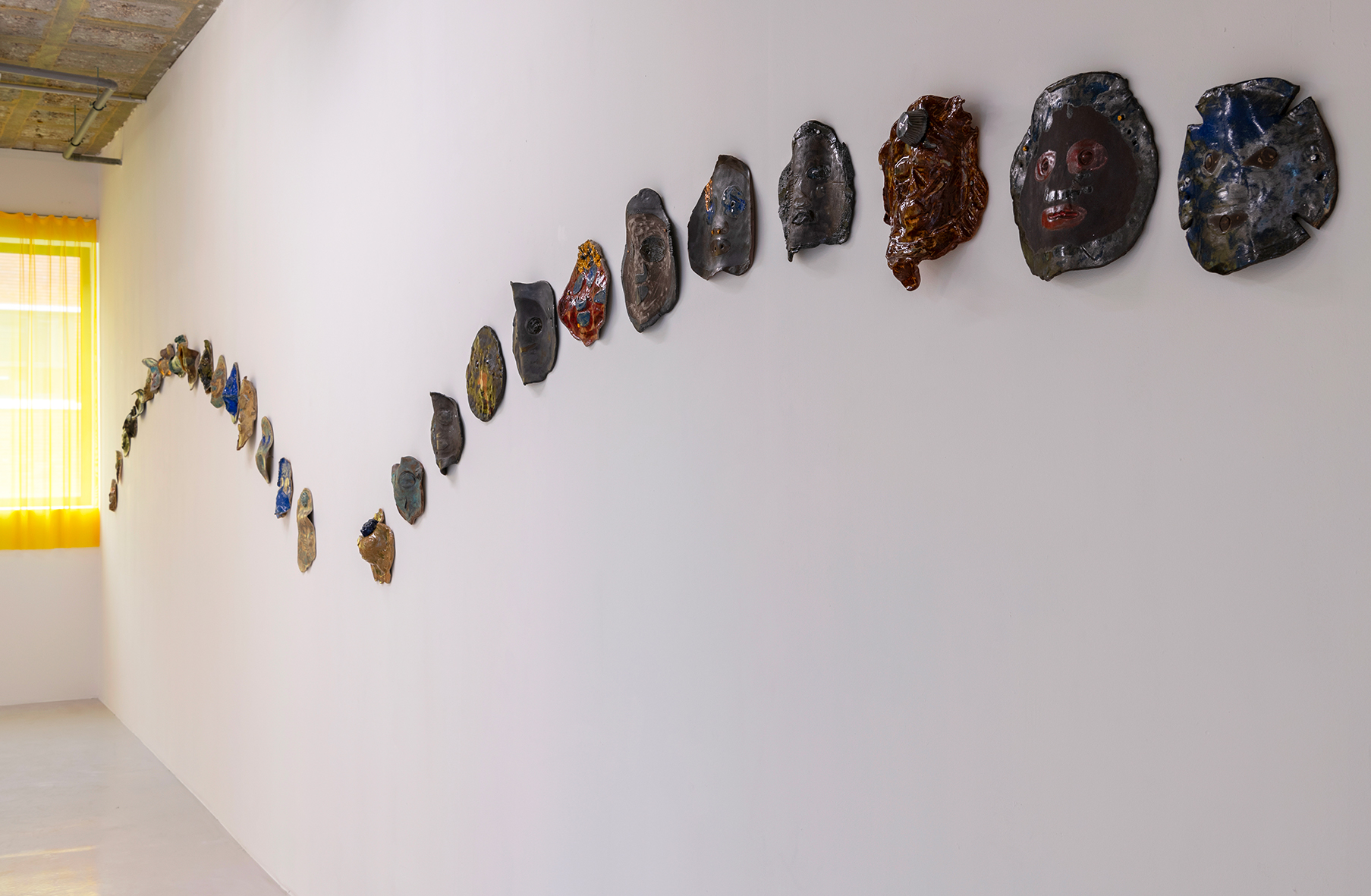
© Photo Marc Domage

© Photo Marc Domage
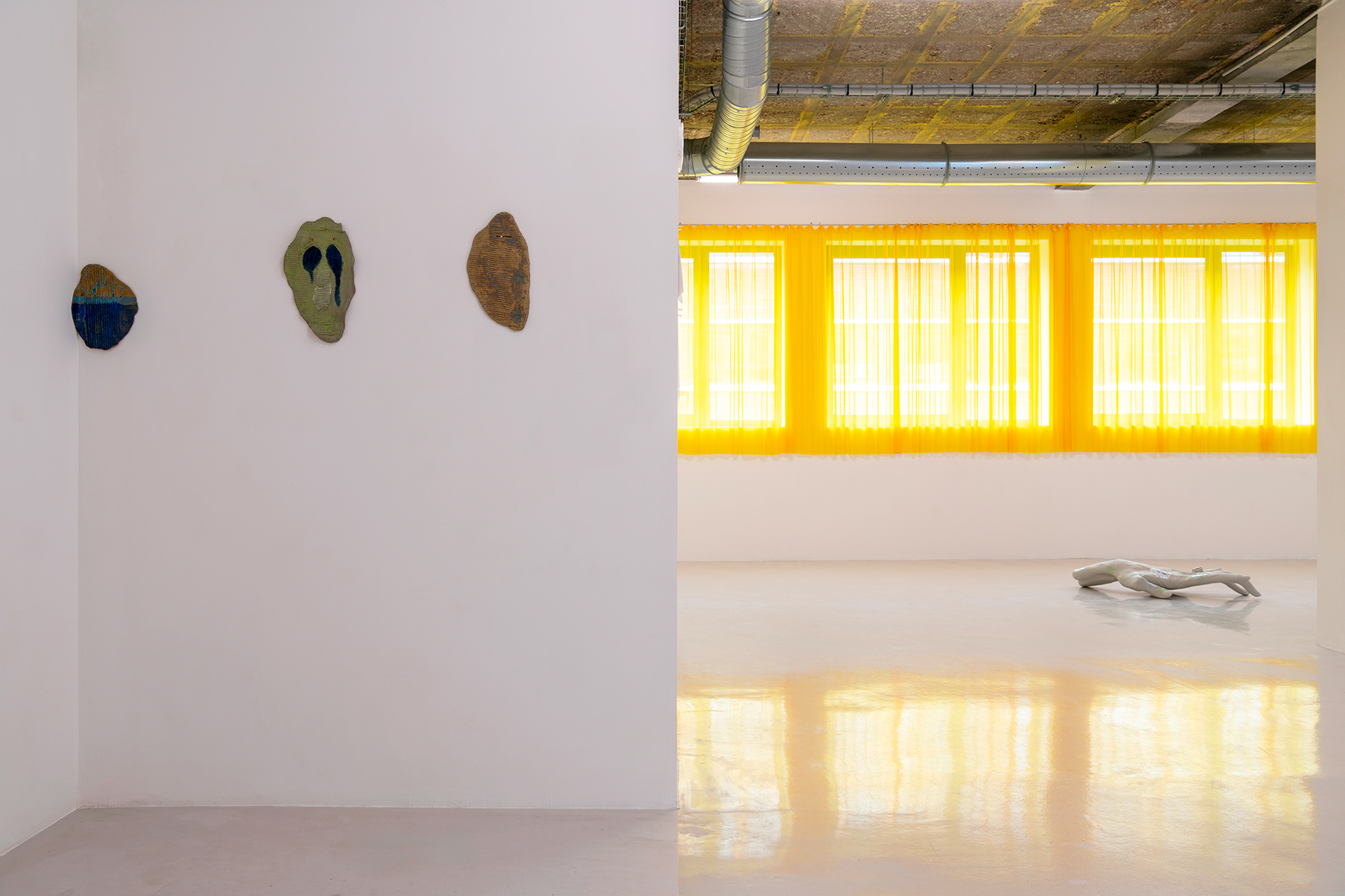
© Photo Marc Domage
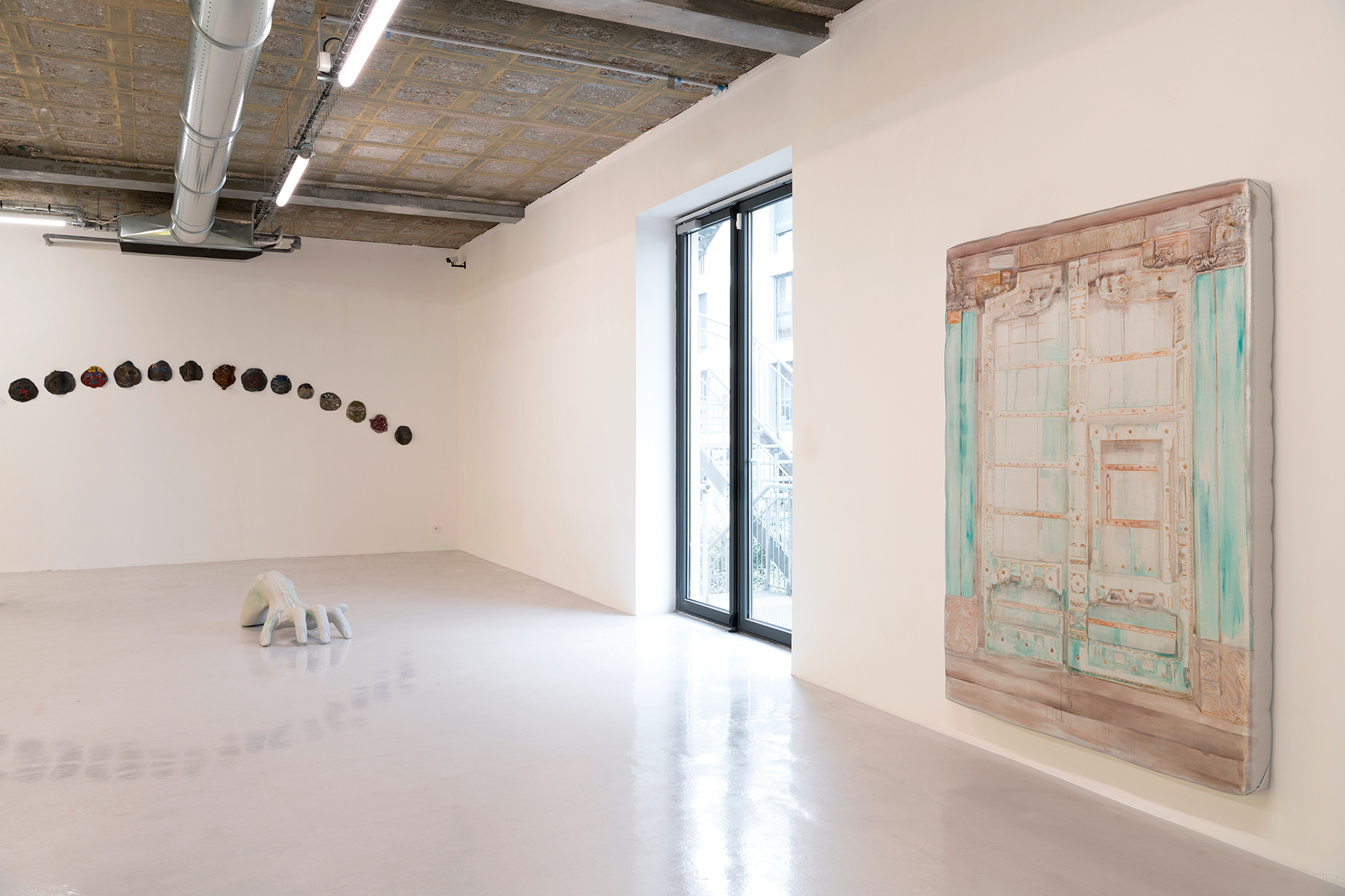
© Photo Marc Domage
The mask is the ultimate anti-object. Semiologists would use the term deictic to describe it — the gesture of a finger pointing over there, somewhere else. Whether it belongs to a Greek tragedy performer, to a member of the Anonymous group, to an immunocompromised citizen or to a Snapchat user, the mask designates something else than itself, and in so doing it also distinguishes iconophiles from iconoclasts. So, there are two options: will you believe what is represented on its illusionist surface, or will you try to take a peek behind the scenes, even if that means being at risk of succumbing to paranoia? Heads or tails, image or object: perhaps the impasse is due to wanting to stick too closely to the lost origin, to mourning some naked face.
It so happens that Ingrid Luche produces masks, and her ceramic masks raise their objectness as a standard. The Air de Paris gallery is showing around forty of them, displayed on the walls or placed on rails. We are finally looking at them for what they are, no longer considering them as mere signs. The works, which are from the “Beauty masks” series (2023-2024), were made using disposable beauty masks pressed onto layers of clay. The imprint of the synthetic fabric remains on the surface of these flexible faces, which come in a wide range of colours, depending on the glazing process and accidents. Each one of them has particular features, as subjective as a face’s thousand variations. Let’s face it: our masks and filters have become autonomous. Thus, no matter how many times we repeat “I’m not a cat” , our protest gets lost ricocheting off the surface of the ostentatious stoneware .
“Now all our things (...) are likely to become evil dolls capable of biting with their sharp teeth” , Fredric Jameson once wrote. Here we are: with Ingrid Luche, things bite and objects take on a life of their own. In addition to masks, her sixth solo exhibition at the gallery presents new pieces from her evolving series: “Bighands” (2022)*, “Moonstep” (2023) and her “Portes” [“Doors”] (since 2012). The title of the show draws from the first series, “La Porte (Dévoré)” [The Door (Devoured)]: a door that opens onto nothing, but which frames a toothed mouth. It no longer simply involves the infamous “hangar décoré” [“decorated warehouse”] by architects Robert Venturi and Denise Scott Brown, but also an “evil doll” made of polystyrene, wood and aluminium. The medium and representation become one, and dualisms merge, devouring each other.
The new door (Austur-Indíafjelagið, 2024) presented by Ingrid Luche at the Air de Paris gallery is marked by the paradoxical materiality of her entire production. Here, the door is a chipboard bed base featuring a painted reproduction of a photograph taken in Reykjavik. More specifically, it is the entrance to an Indian restaurant, as the artist emphasises that “the first manifestations of globalisation are those of culinary culture” . The door embraces a touristic image that, once again, avoids the ordinary use of the sign-image. An image that works should encourage people to push open the door and eat a restaurant’s deceptively local cuisine. But that’s all there is here: the artisanal customising of the disposable dregs of worldwide discount, as part of a series that the artist calls “Chinoiseries”.
Ingrid Luche was born one year after the publishing of Jean Baudrillard’s Système des objets. In fact, Baudrillard’s scathing condemnation was already slightly anachronistic by the time she produced her first works in the early 1990s. While Baudrillard lamented the “tranquillity consecrated by distance from the world” due to disengaged consumerism , Luche produces by and for a society that no longer misses the original. Her object-works and sculpture-signs may display their DIY materiality and artisanal finish, but they fully belong to our current system of thought: that of connected objects which are all but lifeless , in the process of becoming automated, communicating with each other without the help of humans, and greedy for personal data. We often wear them close to our skin — at risk of being devoured by them.
Ingrid Luquet-Gad
Translated by Callisto McNulty
(1) Zoom Cat Lawyer” or “I’m Not a Cat” refers to an Internet meme. On 9 February 2021, a lawyer logged into Texas’ Judicial District Court, forgetting to disable the chat filter on his Zoom application. When he real-ised his mistake, he defended himself by saying “I’m not a cat”.
(2) In 2016, the artist produced another similar ceramic masks series, “Masques arsoniens”.
(3) Fredric Jameson, La totalité comme complot. Conspiration et paranoïa dans l’imaginaire contemporain, Paris, Les Prairies Ordinaires, 2007, p. 33. [Quotation translated from the French by Callisto Mc Nulty].
(4) See Robert Venturi, Denise Scott Brown and Steven Izenour, L’enseignement de Las Vegas, Bruxelles, Mardaga, 2008.
(5) Interview with the artist, 1 July 2024.[quotation translated from French into English].
(6) Jean Baudrillard, The consumer Society, London (Thousand Oaks, New Delhi: Sage Publication, 1998). Available at https://monoskop.org/images/d/de/Baudrillard_Jean_The_consumer_society_myths_and_structures_1970.pdf
(7) In relation to the ways in which they design everyday life, see: Adam Greenfield, Radical Technologies : The Design of Everyday Life (London: Verso Books, 2017).
* This project was selected by the Fondation des Artistes’ patronage committee, which gave it its support.
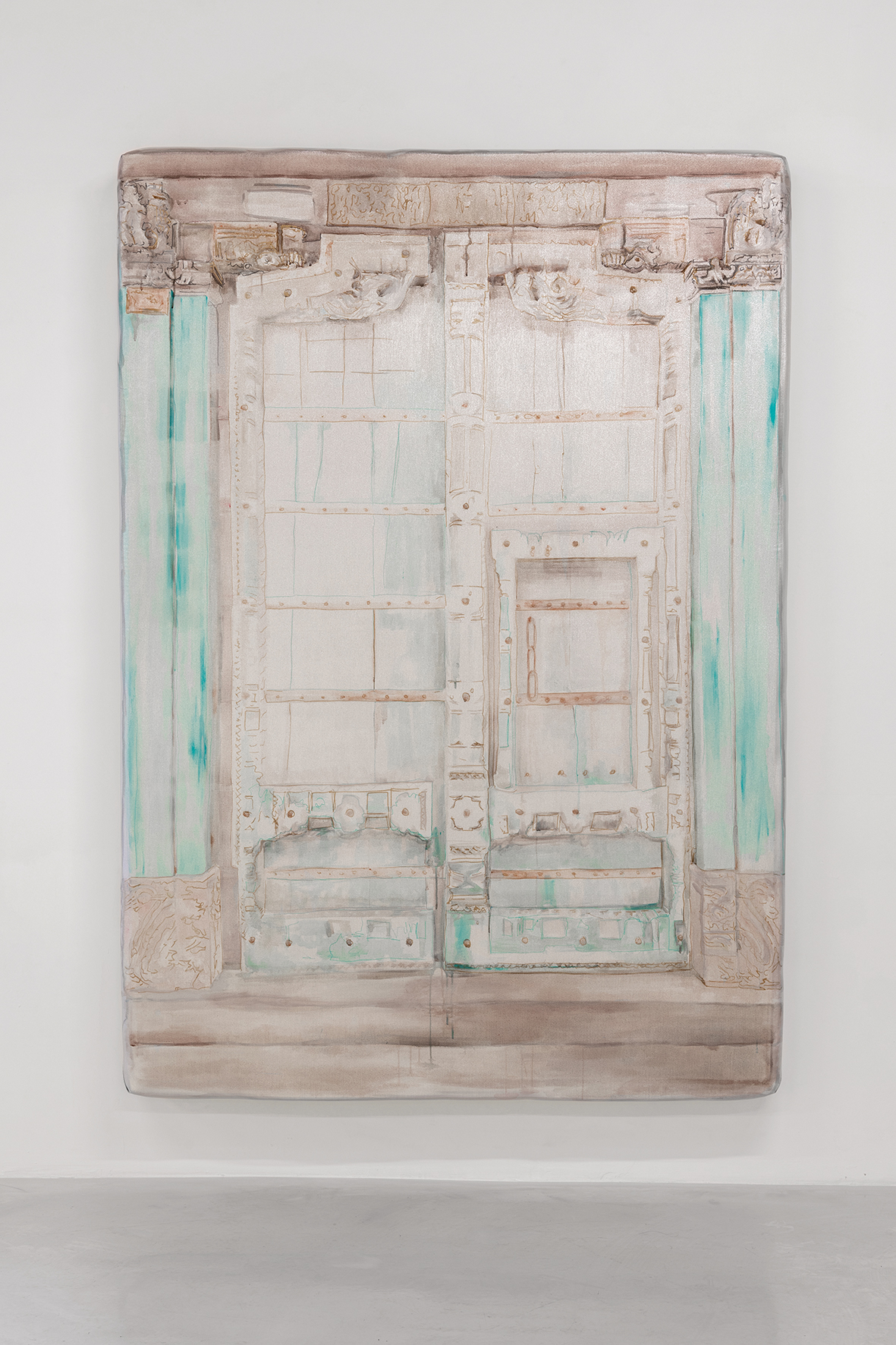
Ingrid Luche, La Porte Austur-Indíafjelagið, 2024. Ikea wooden and foam bed frame, polyester, acrylic paint, 196 x 140 x 13 cm. Unique. © Photo Marc Domage
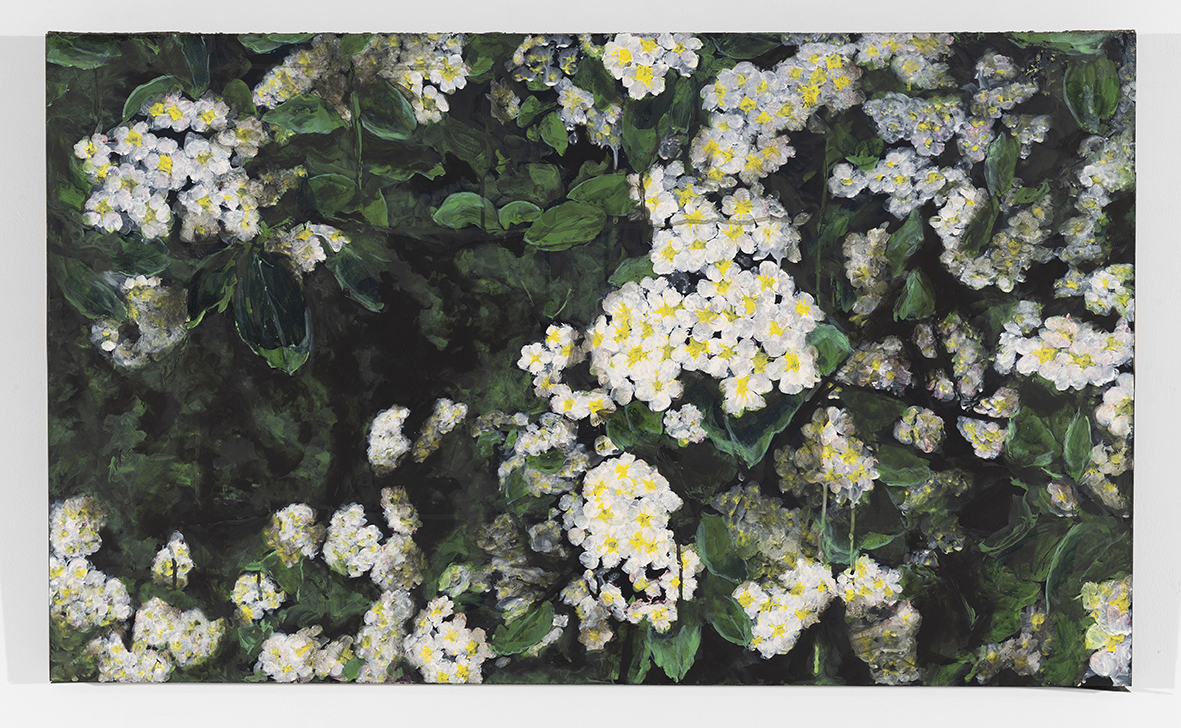
Ingrid Luche, Chinoiserie (Vincennes avril 2020), 2021. Qcrylic and varnish painting, ink, phosphorescent paint,stratified chipboard, ca. 60 x 100 x 4 cm. Unique. © Photo All Rights Reserved
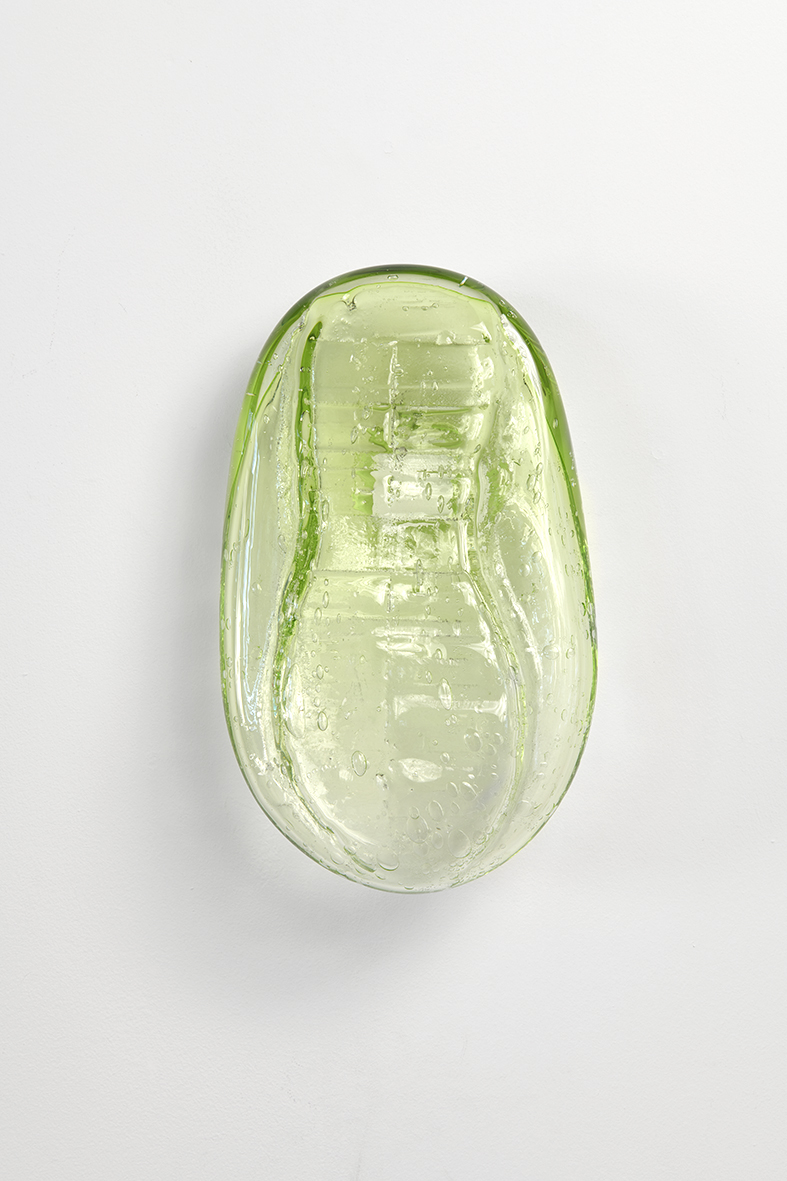
Ingrid Luche, Moonstep n°1, 2023. Molded and blown glass, 27,5 x 9 x 17,5 cm. Unique. © Photo Marc Domage
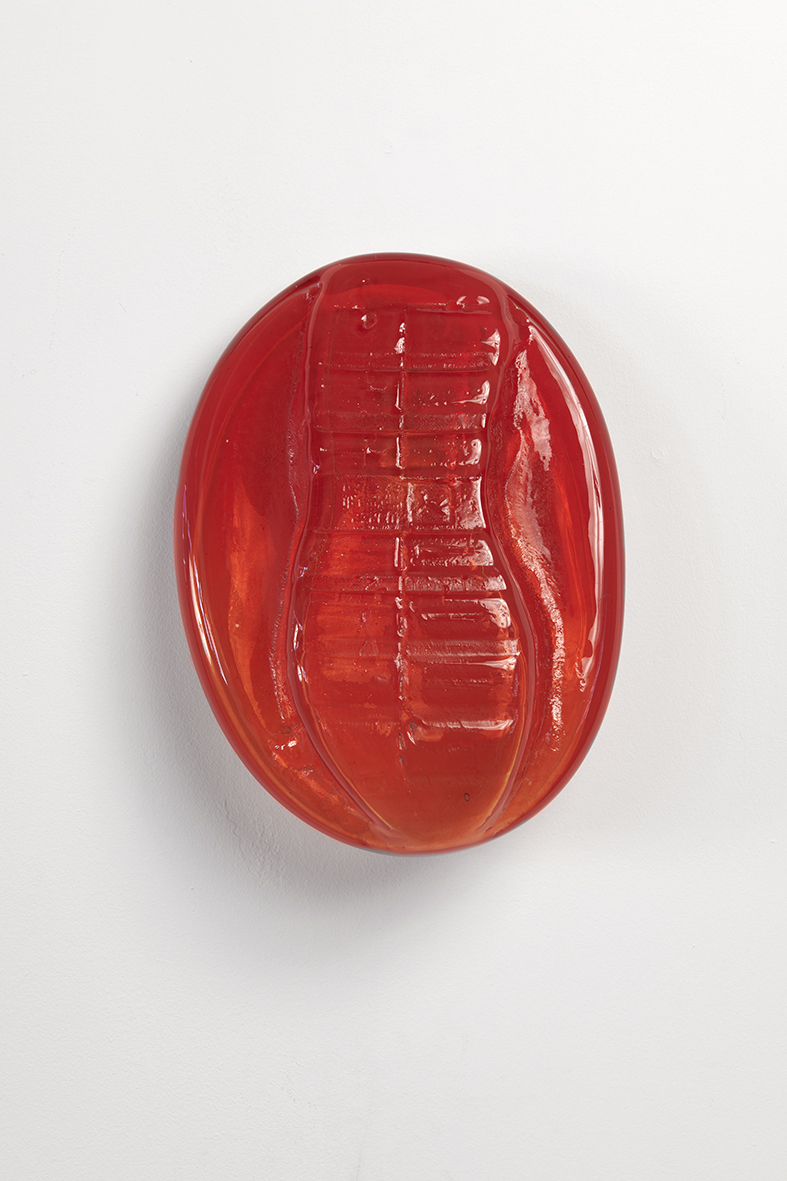
Ingrid Luche, Moonstep n°4, 2023. Molded and blown glass, 27 x 8 x 20 cm. Unique. © Photo Marc Domage

Ingrid Luche, Bighand (1D), 2022. PU resin 350g, Soft touch paint, acrylic paint, 52 x 123 x 70 cm. Unique. © Photo Marc Domage
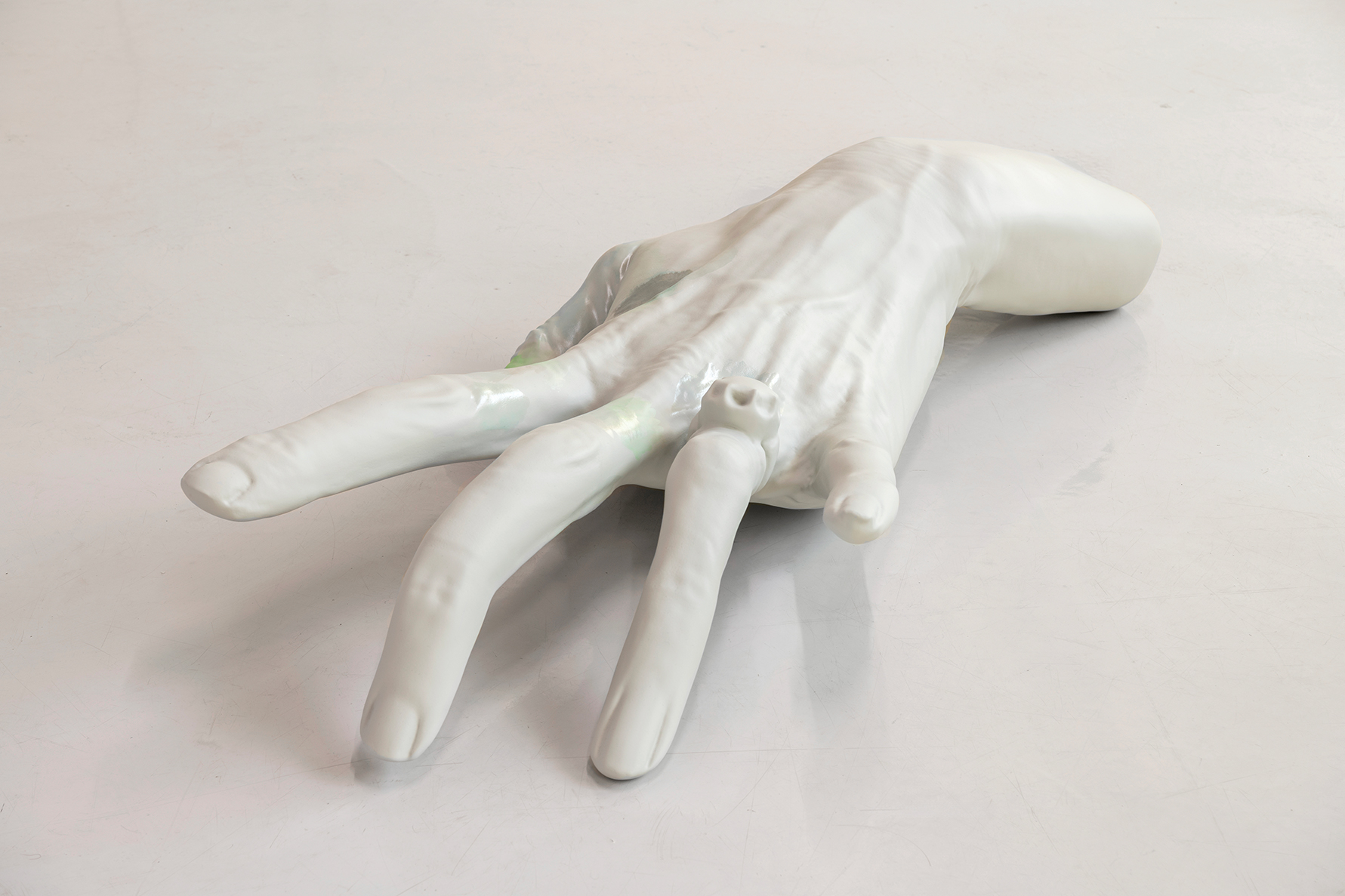
Ingrid Luche, Bighand (1G), 2022. PU resin 350g, Soft touch paint, acrylic paint, 25 x 132 x 63 cm. Unique. © Photo Marc Domage
|

